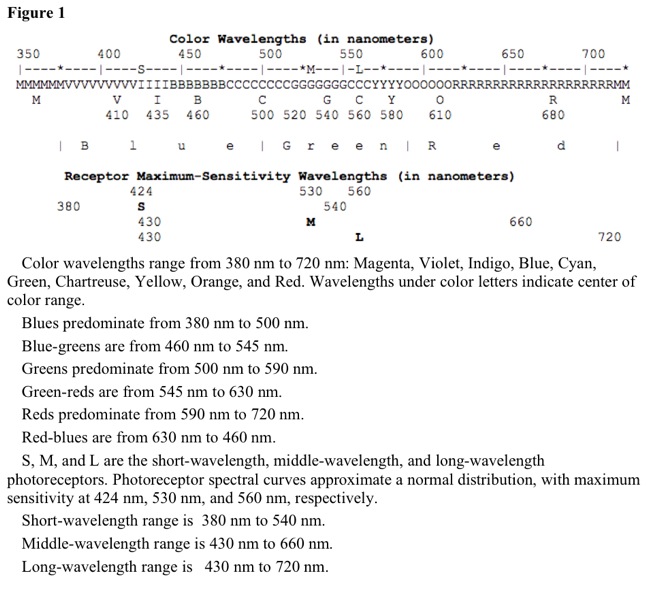
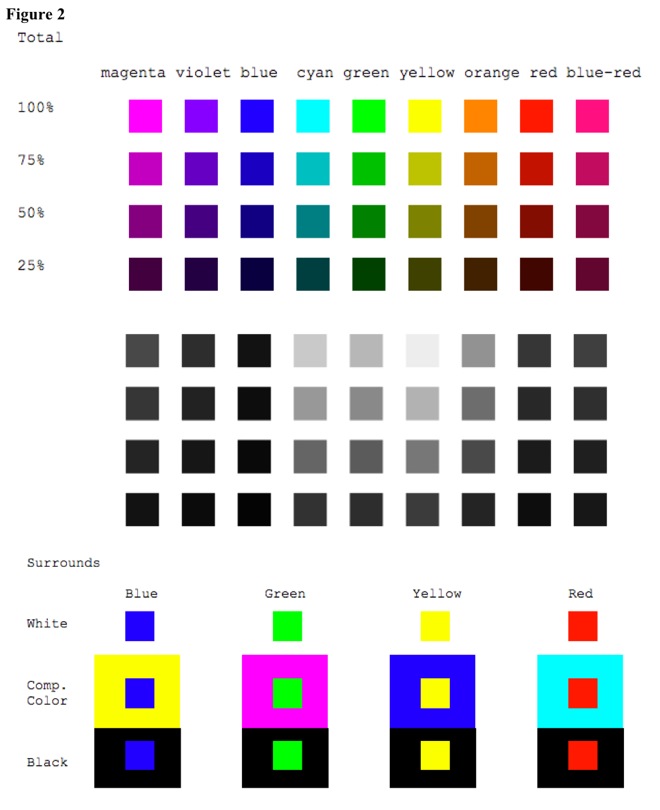
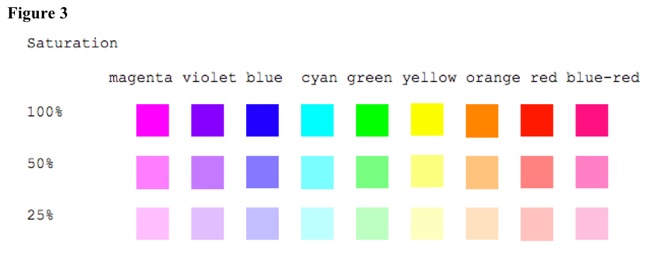
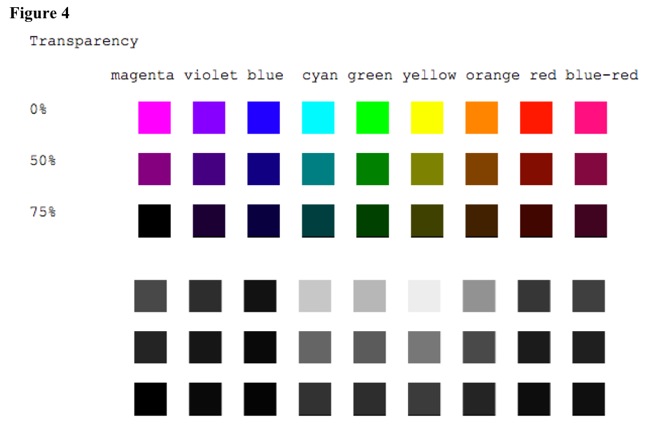
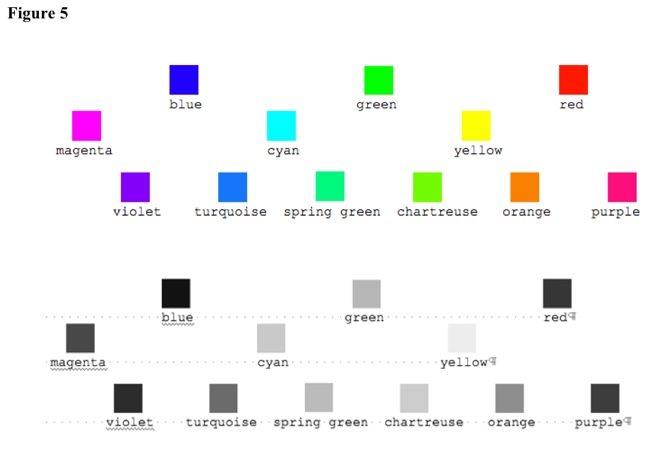
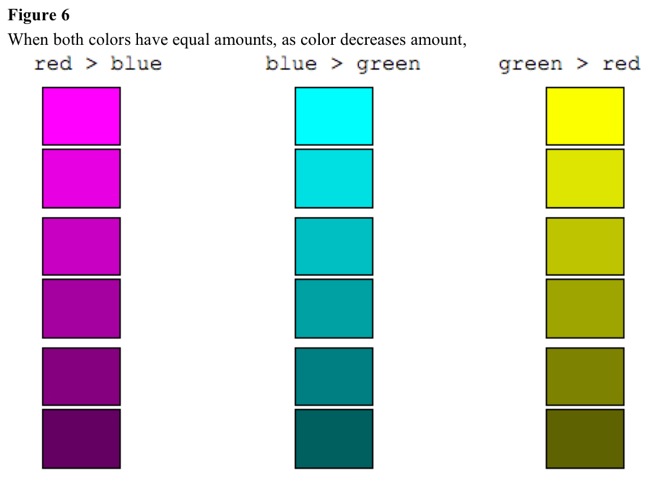
Color has brightness, hue, and saturation {color properties}. Color properties come from black-white, red-green, and blue-yellow opponent processes.
hue
Hue depends on electromagnetic-wave frequency [Krauskopf et al., 1982]. Fundamental color categories are white, gray, black, blue, green, yellow, orange, brown, red, pink, and purple [Kay and Regier, 2003]. White, gray, and black mix red, green, and blue. Brown is dark orange. Pink mixes red and white. Purple mixes red and blue. See Figure 1.
Alternatively, colors have six categories: white, black, red, yellow, green, and blue. Blue and red have no green or yellow. All other colors mix main colors. Purple mixes red and blue. Cyan mixes green and blue. Chartreuse mixes yellow and green. Orange mixes red and yellow. Pink mixes red and white. Brown mixes orange and black.
brightness and blackness
Color brightness depends on electromagnetic-wave intensity [Krauskopf et al., 1982]. Darkness is the opposite of brightness and is the same as added blackness. Colors can add black, and white can add black. Black adds to colors linearly and equally. See Figure 2. At all brightness levels, white looks lightest, yellow looks next lightest, green looks next lightest, red looks next lightest, blue looks darker, and black looks darkest.
White surroundings blacken color. Complementary-color surroundings enhance color. Black surroundings whiten color.
saturation and whiteness
Color saturation depends on electromagnetic-wave frequency distribution [Krauskopf et al., 1982]. Colors can add white, and black can add white. White adds to colors linearly and equally. Complete saturation means no added white. Lower saturation means more white. No saturation means all white. Less saturation makes colors look lighter. See Figure 3. Black looks most saturated. At all saturation levels, blue looks next most saturated, red looks somewhat saturated, and green looks less saturated. White looks least saturated.
transparency and opacity
Color transparency depends on source or reflector electromagnetic-wave density. Opaqueness means maximum color density, with no background coming through. Transparency means zero color density, with all background coming through. See Figure 4. With a white background, opacity is the same as saturation, and transparency is the same as no saturation, so colors are the same as in Figure 3. With a black background, opacity is the same as lightness, and transparency is the same as darkness, so colors are the same in Figures 2 and 4. Blue looks most opaque, and green looks least opaque.
color strength
For all color brightnesses, when both colors have equal brightness, black suppresses one color more {color strength}. Red is stronger than blue, because frequency is lower and wavelength is higher. Blue is stronger than green, because frequency is lower and wavelength is higher. Green is stronger than red, because frequency is lower and wavelength is higher. See Figure 6. Less blue needs to balance green and red, so blue is darker than red and green. Less red needs to balance green, so red is darker than green.
For all color brightnesses, when stronger color is 32 bits lower, weaker color can appear. See Figure 6.
Relative color strengths are the same no matter the computer-display color profile, contrast level, or brightness level.
mixtures
Blue is most dark, opaque, saturated, and cool. Red is less dark, opaque, and saturated and most warm. Green is least dark, opaque, and saturated and neither cool nor warm. See Figure 5, which displays the primary colors, their 1:1 mixtures plus CYMK mixtures, and their 2:1 mixtures.
Magenta mixes blue and red. In its group, it is most dark, opaque, saturated, and neither cool nor warm. Cyan mixes blue and green and so is less dark, opaque, and saturated and most cool. Yellow mixes red and green and so is least dark, opaque, and saturated and most warm. Because they add colors, magenta, cyan, and yellow do not directly compare to blue, green, and red.
Violet mixes blue and some red. In its group, it is most dark, opaque, and saturated and slightly cool. Purple mixes red and some blue and so is less dark, opaque, and saturated and is slightly warm. Turquoise mixes blue and some green and so is less dark, opaque, and saturated and is slightly cool. Orange mixes red and some green and so is less dark, opaque, and saturated and is warm. Spring green mixes green and some blue and so is less dark, opaque, and saturated and is neither warm nor cool. Chartreuse mixes green and some red and so is least dark, opaque, and saturated and is neither warm nor cool. Because they add colors differently, these six colors do not directly compare to magenta, cyan, and yellow or to blue, green, and red.
Mixing blue and yellow, green and magenta, or red and cyan makes white, gray, or black, because blue, green, and red then have ratios 1:1:1. White is lightest, because it adds blue, green, and red. Gray is in middle, because it mixes blue, green, and red. Black is darkest, because it subtracts blue, green, and red.
color properties
Physically, light waves have frequencies with intensities. Physiologically, colors are dependent and mixed (synthetic) and have brightness, hue, and saturation. Brightness depends on intensity and ranges from dim to bright. People can distinguish 100 intensity levels. Hue depends on average light frequency and ranges across the color spectrum, from red to violet. People can distinguish 100 hues. Saturation depends on light-frequency distribution and ranges from unsaturated to saturated. People can distinguish 100 saturation levels. Brightness, hue, and saturation define colors. People can distinguish one million colors. Vision perceptual processes also find color temperature and color lightness. Relative light intensities determine brightness. People can distinguish 100 brightness levels. Relative salience and activity determine color temperature, which ranges from cool to warm. People can distinguish 100 color temperatures. Relative transparency determines color lightness, which ranges from dark to light. People can distinguish 100 color lightnesses. Color brightness, temperature, and lightness define colors.






Consciousness>Consciousness>Speculations>Sensation>Psychology>Sense>Vision
1-Consciousness-Speculations-Sensation-Psychology-Sense-Vision
Outline of Knowledge Database Home Page
Description of Outline of Knowledge Database
Date Modified: 2022.0224